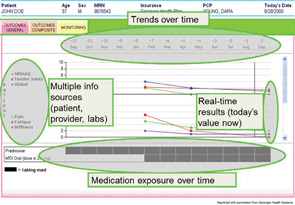“Of those I interviewed, many providers said if the patient was on glucocorticoids more than three months or more than six months, they would be more likely to give a coprescription.”
Dr. Kohler called for more education of primary-care providers regarding this important recommendation.
Rheumatology Data Collection

Dr. Newman
Electronic health records do not provide all the information that rheumatologists need, contends Eric D. Newman, MD, director of rheumatology at Geisinger Medical Center in Danville, Pa. Therefore, he and his coworkers designed and studied implementation of a visual display software program that allowed them to collect the objective information they need (see Figure 1). Called Rheum-PACER (for Patient-Centric Electronic Redesign), the web-based software uses a touchscreen questionnaire to collect information, such as demographics, from patients. An instant nurse messaging system—a novel feature, according to Dr. Newman—allows nurses to track the patient’s progress and assist if needed. The software assembles the information from the patient, nurse, physician, and health record.
When the physician examines the patient and enters data, such as symptoms and disease activity, into the program, the software gives results in real time. It also creates a clinic note and moves it into the electronic medical record, and allows printing of an after-visit summary for the patient. A two-year study showed an 86% adoption rate of the software among physicians, said Dr. Newman. More than 1,400 patients with RA participated in the study. For those patient visits, the new program significantly increased provider productivity, measured by relative value units, and net revenue rose by 26% for each visit (P =.03 each).
The software is not yet commercially available, said Dr. Newman. Other presentations included using electronic health records to generate run charts that help monitor performance in treating various rheumatologic diseases at Cincinnati Children’s Hospital. A quality-improvement project from Nationwide Children’s Hospital in Columbus, Ohio, also improved the electronic patient record. To increase the influenza vaccination rates in pediatric rheumatology clinics, the researchers added a best-practice alert about vaccination that providers saw on a pop-up screen whenever they signed orders. The investigators reportedly more than tripled the rate of influenza immunization in two years.
Projects Target ACR Priorities
Session comoderator Jinoos Yazdany, MD, MPH, assistant professor of medicine at the University of California, San Francisco, and a member of the ACR Quality Measurement White Paper Development Workgroup, told The Rheumatologist she was excited that the researchers applied to their real-world settings some of the quality measures that the ACR has endorsed. “At this session, we saw rheumatologists applying data and innovations in health information technology to drive quality improvement at their institutions, with significant impact,” she said. “It is very likely that some of the successful measures-development and implementation projects performed by rheumatologists in their own communities will help inform what we do at the ACR at the national level.”

